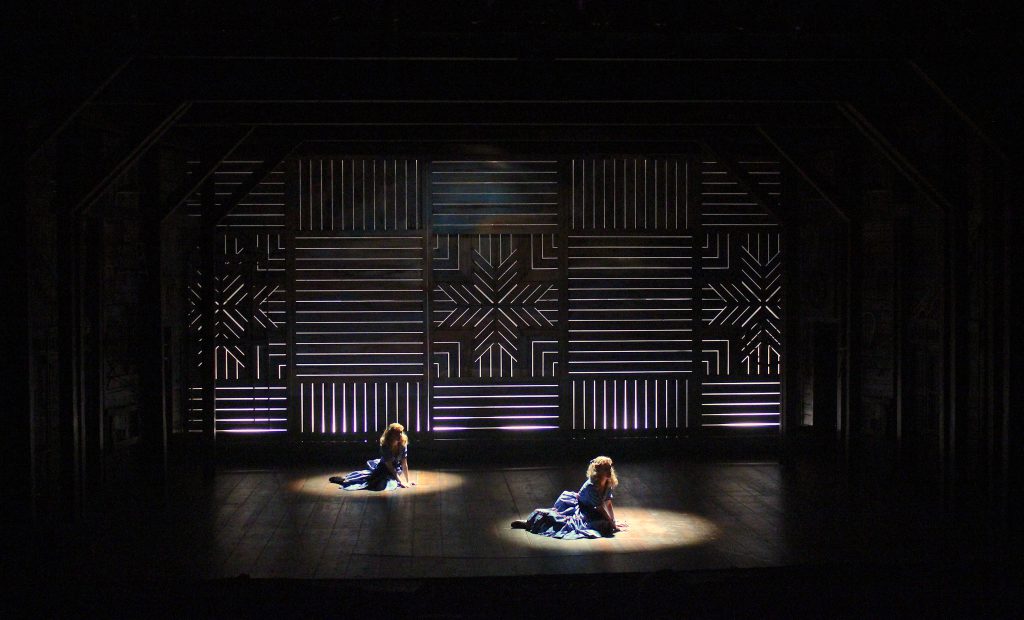Lighting Is Part Of The Play
Posted on July 27, 2017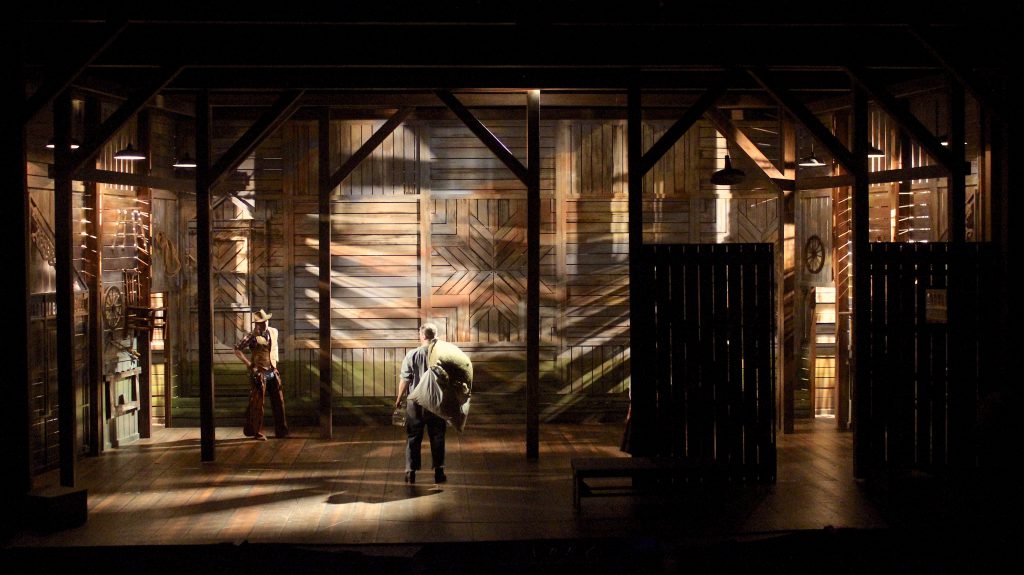 For Zach Blane theatrical lighting is not merely an effect, but an acting role in its own right. Like any actor, he says, lighting should exude its own emotional force, as it contributes to the overriding narrative of the play. Considering himself a “Dramaturgical Storyteller” rather than a “Lighting Designer,” Blane weaves his lighting tightly into its onstage surroundings. Through its interaction with scenic elements and “other actors,” his lighting serves the play by helping to convey its meaning in the truest possible terms.
For Zach Blane theatrical lighting is not merely an effect, but an acting role in its own right. Like any actor, he says, lighting should exude its own emotional force, as it contributes to the overriding narrative of the play. Considering himself a “Dramaturgical Storyteller” rather than a “Lighting Designer,” Blane weaves his lighting tightly into its onstage surroundings. Through its interaction with scenic elements and “other actors,” his lighting serves the play by helping to convey its meaning in the truest possible terms.
The power of Blane’s storytelling approach to lighting was brought home to us in a recent production of Oklahoma! at the John W. Engeman Theatre, where he lit the entire show in a tint spectrum to convey the dream-like elements of the Rogers and Hammerstein classic.
Intrigued, we asked Blane to share some insights into his design philosophy. Taking time from his busy schedule, he discussed a wide range of topics with us, from the importance of collaborating with set designers and directors, to the impact of technology on his work, and the art of serving a play’s narrative in light.
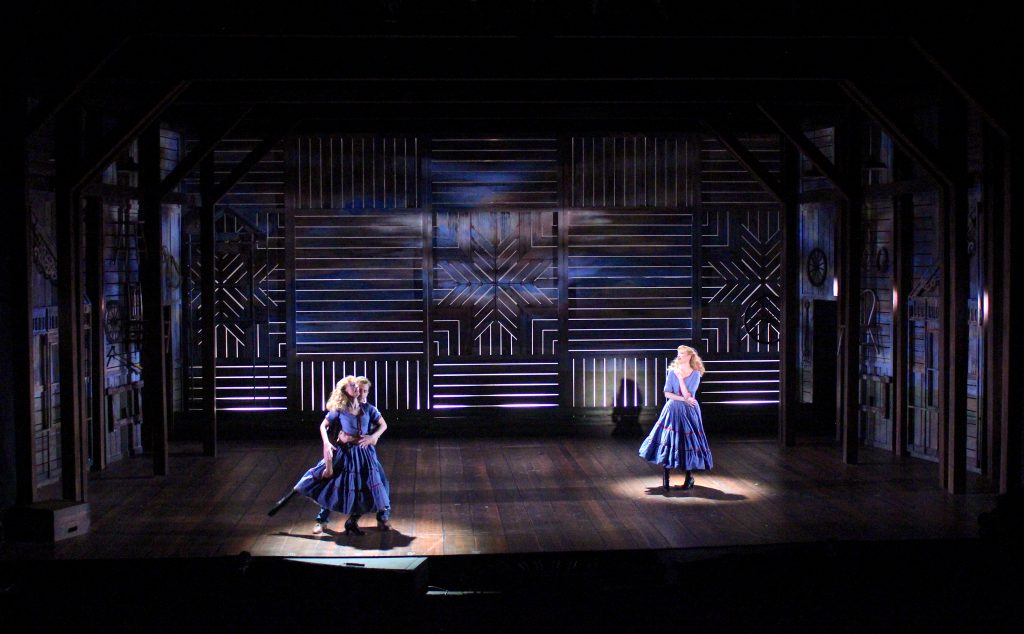 Your work on Oklahoma! with D.T. Willis’ set was quite impressive and obviously required close collaboration between him and you. What are the keys to a successful lighting designer-scenic designer collaboration?
Your work on Oklahoma! with D.T. Willis’ set was quite impressive and obviously required close collaboration between him and you. What are the keys to a successful lighting designer-scenic designer collaboration?
“Thank you. I think the key is to really crack the dramaturgical needs of the script first. Any answer we may require can be found in the script itself. D.T. and I especially speak at length, about what the visual imagery of the set and lighting will mean to the piece, and how it will impact the emotional experience of the audience. I think the paramount thing in a successful collaboration between any design disciplines is to check your ego at the door. We are there to serve the piece, and I am a true believer that ‘the best idea in the room wins,’ whether that is mine, or someone else’s. All I care about is getting across that finish line, not how we got there necessarily.”
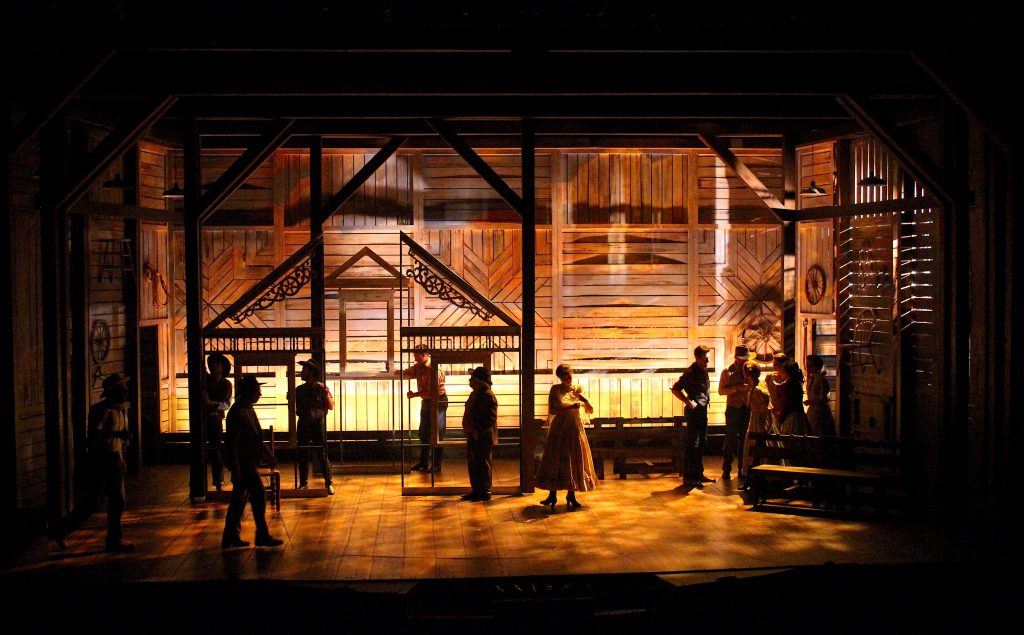 Can you give us an idea how the process of melding lighting and scenic design works? Which comes first? Do you wait to see the scenic design before developing your light plot?
Can you give us an idea how the process of melding lighting and scenic design works? Which comes first? Do you wait to see the scenic design before developing your light plot?
“I think it is different in every process. I like mostly to work hand-in-hand with the scenic designer to achieve the main goal of supporting the director’s visual of the production. In reference to Oklahoma!, Igor Goldin truly gave us the parameters to work within. D.T, Igor, and I have worked together many times in the past, so our shorthand and feelings on certain choices have become very streamlined, and second-nature, which always helps!”
 It seems that sets have become more elaborate today. How does this influence your work as a lighting designer?
It seems that sets have become more elaborate today. How does this influence your work as a lighting designer?
“Real estate, in terms of where I can place lighting fixtures, is always a conversation these days. Typically I receive a version of the set, and then the set designer and myself chat through priorities and goals, and figure out how we can adapt the layout of the set to be able to fit certain angles and qualities of light we know we will want in the setup. I actually think that in recent years, lighting has become more elaborate than any other design medium. The days of ‘lights up, lights down’ are a thing of the past, as lighting designers truly — thanks to modern technology — are delivering the story to the audience, subconsciously, telling them how to feel and how to look at the piece. This was not the case in the past. Now the lighting designer absolutely has a ‘seat at the table’, more so than ever, so we can discuss how we get from point A to point B.”
 In recent years, there have been a lot of new high tech scenic materials that have appeared. How does this impact you as a lighting designer?
In recent years, there have been a lot of new high tech scenic materials that have appeared. How does this impact you as a lighting designer?
“In terms of video design entering the space, I think it impacts lighting quite a bit. I think it is hard for a typical audience member to be able to decipher the difference between projections and lighting design. Both disciplines deal in the medium of ‘light’. To that fact, I believe that a close collaboration with the video, scenic, and lighting designer is crucial! I recently lit a national tour called ‘Crane, On Earth, In Sky’ and the video designer Kate Freer and I worked hand-in-hand, every step of the way, deciding how to deliver this story. At times I took the lead, and at other times she did. We spoke about shape, form, and color throughout, and it was a constant collaboration all with the same goal in mind. The best relationship between video and lighting shows in the work, when the audience truly cannot tell what is light and what is video in the best way possible.”
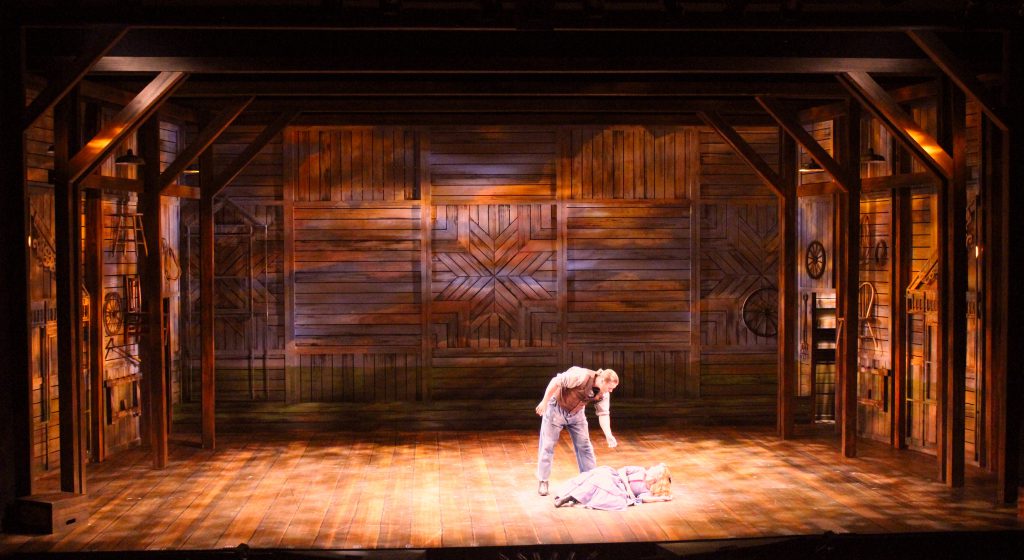 The advent of LEDs allows you to place lights much closer to and often inside scenic elements. How does this influence your work? What sort of factors play a role in your decision to light something from within rather than from outside?
The advent of LEDs allows you to place lights much closer to and often inside scenic elements. How does this influence your work? What sort of factors play a role in your decision to light something from within rather than from outside?
“I think this is truly a case by case scenario. Truly everything is based on what the collective creative team is trying to achieve, so how the physical production ends up LOOKING is almost secondary, compared to how the production is FEELING.”
 It seems like more sets have roofed scenic elements, such as the barn in Oklahoma! When you have such a set, do you make your lights part of the scenic element?
It seems like more sets have roofed scenic elements, such as the barn in Oklahoma! When you have such a set, do you make your lights part of the scenic element?
“Yes and no. I did a production of a new play called Sommerfugl (written by Bixby Elliot) that was directed by Stephen Brackett, and scenic designed by Jason Sherwood. This production was an ‘alleyway’ setup, and had a HUGE ceiling piece built into the initial scenic design. During our first design meeting, when Jason presented the first pass to us, I had said if we are going to do a full ceiling, we should utilize it as a surface, and incorporate lighting into it as if it were a character and could mold and change as the evening went on. We then went through a few different versions, and landed on a full LED Lightbox that had lanes of oblong lamps with exposed filaments throughout. This became a sculptural piece, even more so, when we added the lighting elements to this structure, as well as a storytelling device.”
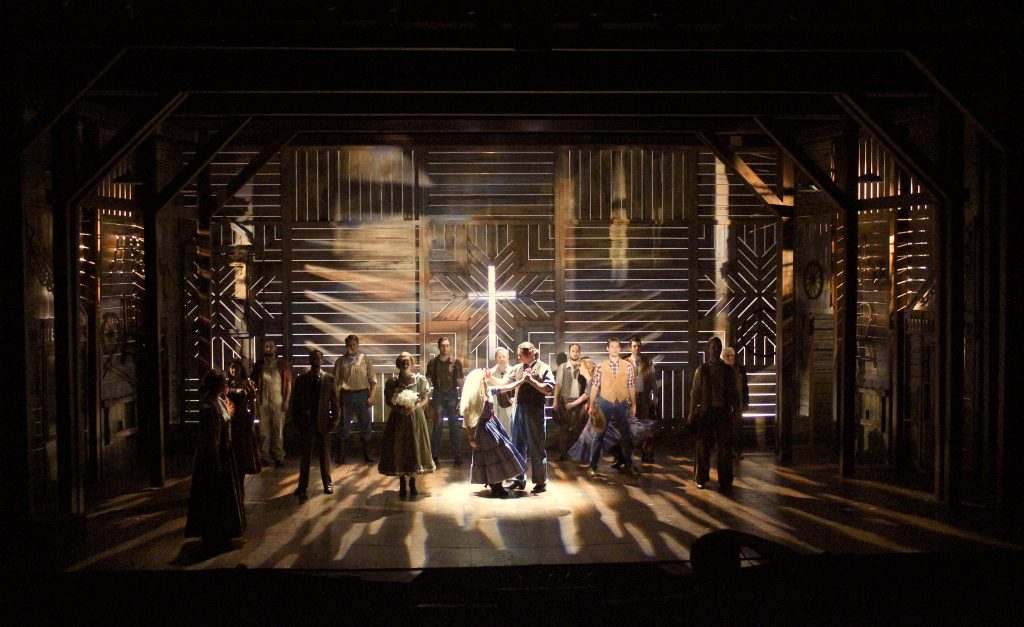 On the subject of lighting scenic elements, can you talk a little about the difference between lighting them and an actor?
On the subject of lighting scenic elements, can you talk a little about the difference between lighting them and an actor?
“I think it is one in the same. Both items are inhabiting the same space at the same time. I think of lighting as a ‘character’ in itself. Due to that fact, I am constantly thinking about how the ‘behavior’ of the lighting is affecting the set, and the ‘scenic space’ as much as it is affecting the actor’s character, currently inhabiting it. One informs the other, which then telegraphs psychological information to the audience so they subconsciously have the most clarity required for each beat of each scene to receive the story the clearest way possible.”
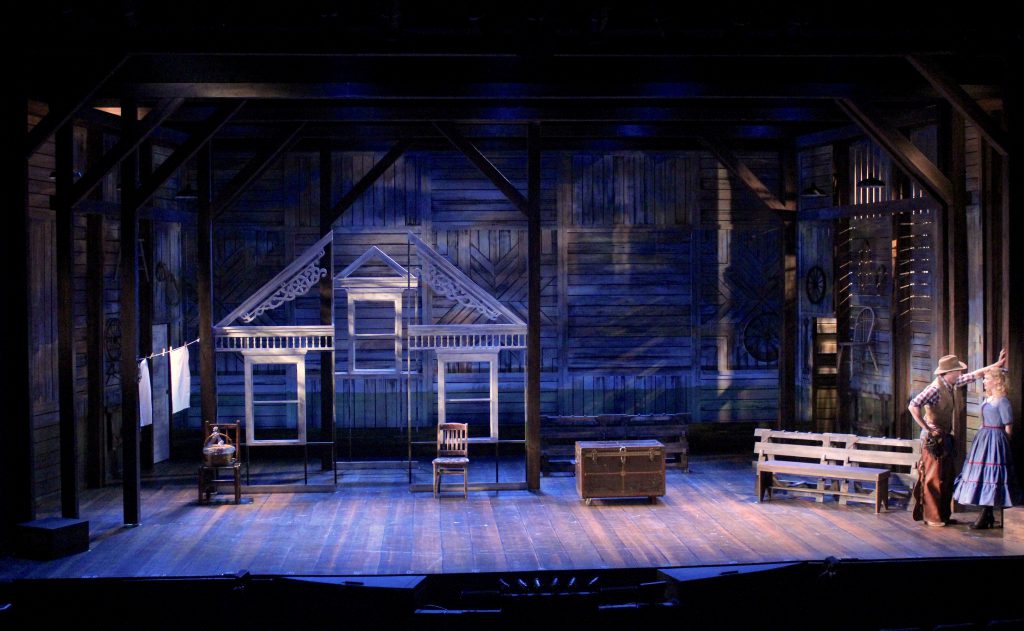 Is there one common mistake that designers too often make when designing scenic elements?
Is there one common mistake that designers too often make when designing scenic elements?
“I think the biggest mistake is when a scenic designer comes to the first meeting with the sentence of ‘this is my set, it will not change, figure it out’. That of course is not collaborative, and I think that person has missed the memo that if the lighting designer cannot successfully light the set, then the set will not look good. One hand washes the other!”
